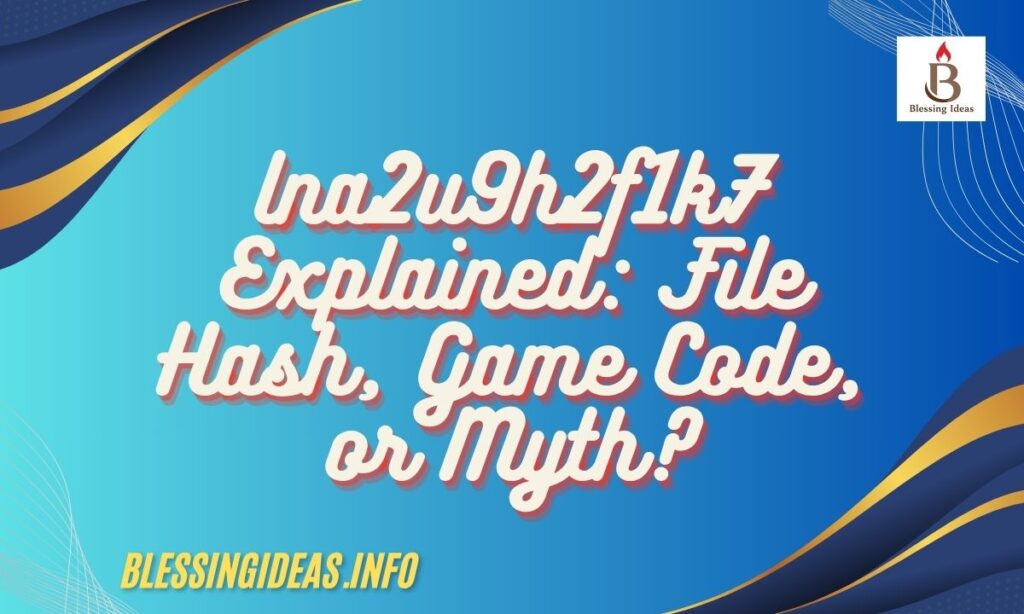The cryptic string “lna2u9h2f1k7” has sparked intrigue across online forums and tech communities. Its seemingly random mix of letters and numbers suggests it could be more than just gibberish, hinting at a specific purpose in the digital world—perhaps a file hash, a game redemption code, or even a clever marketing ploy.
From cybersecurity to gaming culture, “lna2u9h2f1k7″ could fit into various contexts, each with unique implications. It might be a cryptographic hash ensuring file integrity, a unique identifier in a database, or a code promising in-game rewards. Alternatively, it could be a fabricated term designed to drive web traffic.
What is lna2u9h2f1k7? Decoding the Mystery Code
The code “lna2u9h2f1k7” is a 12-character alphanumeric string. It mixes letters and numbers in a seemingly random way. Such strings often have specific purposes in digital systems. They’re rarely arbitrary. They might identify data, secure communications, or unlock content. No official source defines “lna2u9h2f1k7” yet. Its structure suggests multiple possibilities. It could be a hash, an identifier, a game code, or a marketing ploy.
Meanings That Might Apply at a Glance
The code could serve several roles. Here’s a quick overview:
| Possible Meaning | Description |
| File Hash | A unique fingerprint for verifying file integrity. |
| Data Identifier | A label for tracking data in databases or APIs. |
| Redemption Code | A code for unlocking content in games or apps. |
| Marketing Keyword | A term to boost website traffic via search engines. |
These possibilities shape how we interpret “lna2u9h2f1k7.” Let’s explore each in detail.
The Role of lna2u9h2f1k7 in Cybersecurity as a File Hash
A file hash is a strong candidate for “lna2u9h2f1k7.” Hashes are unique strings generated from data. They act like digital fingerprints. Even a tiny file change creates a new hash. This makes them vital for security. The code’s length and format fit common hash structures.
How Do File Hashes Work?
File hashes come from algorithms like MD5, SHA-1, or SHA-256. A file’s content is processed to create a fixed-length string. For example, a software developer shares a file’s hash. Users verify downloads by comparing hashes. Matching hashes confirm the file’s authenticity. Mismatches signal tampering or corruption. “lna2u9h2f1k7” could be such a hash, though its algorithm is unclear.
Practical Applications in Security
Hashes are crucial in cybersecurity. They help detect malware. Antivirus software compares file hashes to known threats. They ensure evidence integrity in digital forensics. A consistent hash proves no tampering occurred. Cloud services use hashes for deduplication. Identical files share one copy, saving space. If “lna2u9h2f1k7” is a hash, tools like VirusTotal could check it against threat databases.
Data and Digital Communication Applications

Beyond security, “lna2u9h2f1k7” might be a data identifier. Unique strings organize complex systems. They label data in databases or APIs. They also secure digital communications. Such codes ensure data moves correctly between systems.
Identifiers in Databases and APIs
Databases rely on unique identifiers. They track users, products, or transactions. Simple numeric IDs are common, but complex strings add security. “lna2u9h2f1k7” could be a user ID or session token. APIs use similar strings to manage data requests. For example, it might label a transaction in a payment system. These identifiers prevent data mix-ups and enhance system efficiency.
Secure Communication Protocol
Secure communications use unique codes. They verify identities during data exchanges. For instance, two systems perform a “handshake” before sharing sensitive data. A code like “lna2u9h2f1k7” could be part of this process. It helps prevent man-in-the-middle attacks. Such codes often stay hidden in system logs. They only surface when logs leak online.
Speculative Application: From Games to Marketing
Not all uses of “lna2u9h2f1k7” are technical. Some theories suggest playful or commercial roles. Online discussions link it to gaming or marketing. These ideas stem from forums and blogs, not official sources.
A Redemption Code for Games?
Many believe “lna2u9h2f1k7” is a game redemption code. Games like Free Fire or PUBG use similar strings. Codes unlock skins, currency, or items. Players hunt for such codes online. However, no game developer confirms “lna2u9h2f1k7” as valid. Mentions appear on unofficial sites. These could be clickbait to draw traffic. Without proof, this remains speculative.
A Keyword for SEO Marketing
Another theory is SEO manipulation. Website owners create pages about obscure terms like “lna2u9h2f1k7.” Curious users search for it, boosting site traffic. This drives ad revenue or sales. Blogs offering vague explanations support this idea. The code might have no real meaning. It could just be a hook to attract clicks.
Risks and Best Practices for Handling Unknown Codes
Unknown codes like “lna2u9h2f1k7” can be risky. The internet is full of scams exploiting curiosity. Mishandling such codes could lead to data theft or malware.
Key Risks to Consider
Phishing scams are a major threat. Fake sites mimic official platforms. They trick users into entering credentials. Clicking links tied to “lna2u9h2f1k7” might lead to malware. Downloads from unverified sources could infect devices. Some sites promise rewards for codes but collect personal data. These scams thrive on vague codes.
Best Practices for Staying Safe
Stay cautious with unknown codes. Verify sources before acting. Only trust official platforms, like game developers’ websites. Avoid entering codes on third-party sites. They may steal your login details. Use antivirus software to scan downloads. Tools like VirusTotal check file hashes for threats. Ignore “too good to be true” offers. Protect your personal information always.
Comparing lna2u9h2f1k7’s Possible Uses
To clarify, here’s a table comparing the code’s potential applications:
| Application | Likelihood | Use Case | Risk Level |
| File Hash | High | Verifying file integrity | Low |
| Data Identifier | Medium | Tracking data in systems | Low |
| Game Redemption Code | Low | Unlocking in-game content | Medium |
| SEO Keyword | Medium | Driving website traffic | High |
This table shows the code’s versatility and risks. Technical uses are safer, while speculative ones carry more danger.
Real-World Examples of Similar Codes

Codes like “lna2u9h2f1k7” appear elsewhere. For example, Steam uses redemption codes for games. Database keys like UUIDs organize data. Hashes like SHA-256 secure software downloads. These examples show how common such strings are. Yet, without context, “lna2u9h2f1k7” remains a puzzle.
Why Context Matters for Mysterious Codes
Context determines a code’s purpose. A hash needs a file to verify. A game code needs an official platform. Without context, speculation grows. Users must trace the code’s origin. Official sources provide clarity. Random blogs are often misleading. Always seek context before acting on such codes.
Frequently Asked Questions
Is lna2u9h2f1k7 a valid game code?
No official game confirms it. It’s likely speculative or clickbait.
Can lna2u9h2f1k7 be a file hash?
Yes, its structure fits common hash formats. Use VirusTotal to check.
Is it safe to enter lna2u9h2f1k7 online?
Avoid third-party sites. Only use official platforms to stay safe.
Could lna2u9h2f1k7 be an SEO trick?
Possibly. Some sites use vague codes to attract search traffic.
How do I verify lna2u9h2f1k7’s purpose?
Check official sources or scan with security tools like VirusTotal.
Conclusion
The code “lna2u9h2f1k7” remains a digital enigma. It could be a file hash, data identifier, game code, or marketing ploy. Each possibility has unique implications. Technical uses like hashes or identifiers are common in systems.
Speculative roles in gaming or SEO lack evidence. The code’s true purpose is unconfirmed. Approach it with caution. Verify sources, avoid risky sites, and use security tools. Digital literacy is key. Stay skeptical and safe when navigating mysterious codes online.






